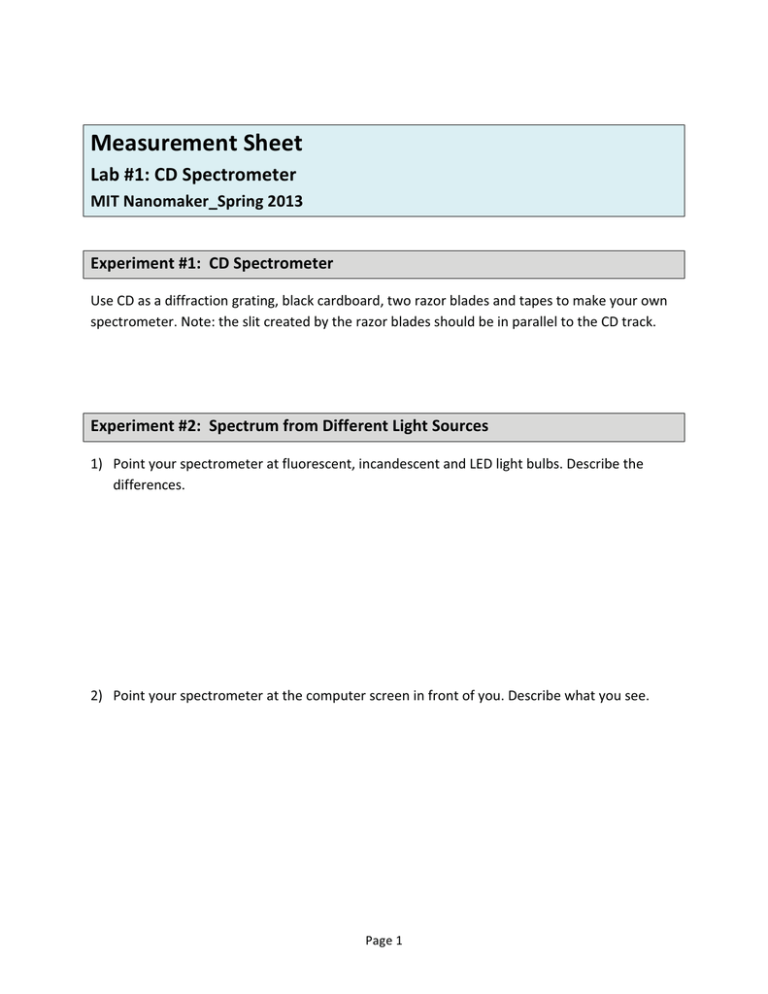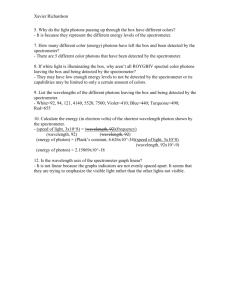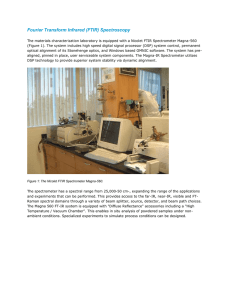Document 13545652
advertisement

Measurement Sheet Lab #1: CD Spectrometer MIT Nanomaker Spring 2013 Experiment #1: CD Spectrometer Use CD as a diffraction grating, black cardboard, two razor blades and tapes to make your own spectrometer. Note: the slit created by the razor blades should be in parallel to the CD track. Experiment #2: Spectrum from Different Light Sources 1) Point your spectrometer at fluorescent, incandescent and LED light bulbs. Describe the differences. 2) Point your spectrometer at the computer screen in front of you. Describe what you see. � Page 1 Experiment #3: Simple Spectrometer Calibration Point your spectrometer at a fluorescent light bulb and take an image with your camera. The three large peaks from the fluorescent spectrum (611, 542, and 436 nm) allow simple wavelength calibration. Please determine the relationship between distance (peaks from the center of the slit) and wavelength. Experiment #4: Spectrometer Calibration with Matlab There is a more quantitative way to calibrate your spectrometer - Matlab. You need to import your picture, read the data-RGB (0-255) for each pixel, and average over several lines. Find the three peaks and then measure the distance between the peaks and the slit in terms of pixel sizes. Please plot the fluorescent spectrum and determine the relationship between pixel and wavelength. Experiment #5: Wavelength Measurement Use your spectrometer to measure the wavelength of given LEDs. You will need a cellphone camera, the requisite cable for the cellphone and a laptop. Wavelength (nm) LED #1 LED #2 LED #3 Page 2 Follow-up Questions: - How does an incandescent bulb work? - How does a fluorescent bulb work? - What is white balance in your camera setting? How is it going to influence spectrum measurements? - A glass windowpane with a thin film of water on it reflects less than when it is perfectly dry. Why? Page 3 - A CD is read from the bottom by a semiconductor laser with wavelength 790 nm passing through a plastic substrate of refractive index 1.8. When the beam encounters a pit, part of the beam is reflected from the pit and part from the flat region between the pits, so these two beams interfere with each other. What must the minimum pit depth be so that the part of the beam reflected from a pit cancels the part of the beam reflected from the flat region? (It is this cancellation that allows the player to recognize the beginning and end of a pit.) ��� ���������� ������� Plastic substrate Laser Page 4 MIT OpenCourseWare http://ocw.mit.edu 6.S079 Nanomaker Spring 2013 For information about citing these materials or our Terms of Use, visit: http://ocw.mit.edu/terms.


